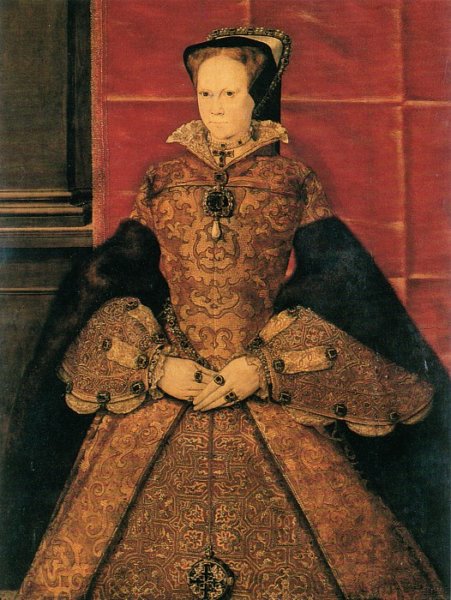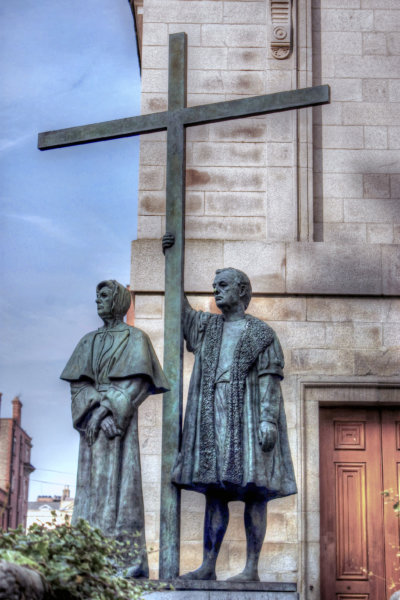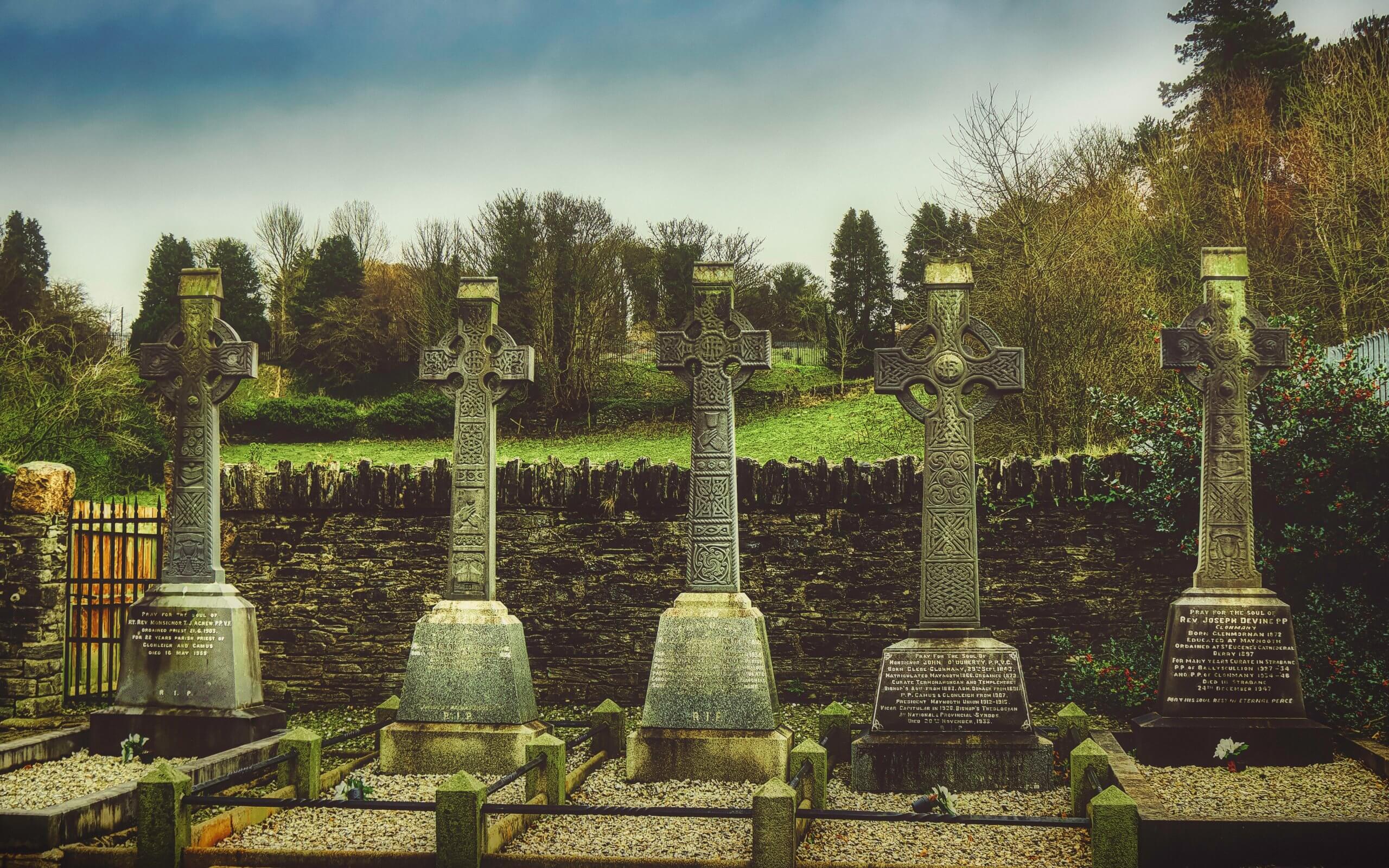Above: graveyard at the Church of the Immaculate Conception in Strabane, Northern Ireland. Photo by K. Mitch Hodge on Unsplash
The Boy King and His Successor
The accession of Edward VI brought the full force of Protestantism to Ireland and the backing of the State to enforce reform. However, the first reading of the new English service in Christ Church Cathedral was marred when an alabaster depicting the Christ of the Passion started to miraculously bleed in a side chapel. In Ossory, a simple layman called Gilpatrick suffered imprisonment for publicly denouncing the reforms and the abolition of the Latin Mass. At his trial, he “declared his intention of preventing as many as he could either by force or persuasion from attending the new services.”
In 1553, two vital Irish bishoprics were left vacant when the Bishop of Ossory died, and the Archbishop of Armagh fled into exile to Rome. The Crown used the opportunity to promote the cause of Protestantism and appointed two Englishmen to the sees but their reception in Ireland was to be a manifest disaster. Goodacre, the appointee to Armagh was poisoned before he could leave Dublin by a delegation of his own diocescan clergy. Bale, the appointee to Ossory, was to have a longer trial.
Upon his arrival in Ireland, Bale was astounded to find the Protestant prayer book operating only in a handful of churches, and even there, the Latin Mass was celebrated soon after. Even among colonial loyalists, he found little enthusiasm for the cause of reform. He wrote to London, somewhat fearfully, that he was met in Waterford, not with a welcoming party, but with priests singing requiems for his soul. His efforts to impose reform in Kilkenny met with little success, failing even to have the images removed from the city’s churches. His brief tenure in Ossory was inaugurated by the arrival of Thomas St. Lawrence, the retired Attorney General for Ireland, who urged the people of the diocese to expel the bishop from his seat and restore their ancient faith to its rightful place.
He need not have bothered.

Soon after St. Lawrence arrived in Kilkenny, the royal herald in the city announced that the boy king was dead and his sister, the resolutely Catholic Mary had ascended to the throne, signalling the immediate return of official favour to the Catholic faith across the island. The work of restoration in Ireland was not the mammoth task as it was in England, for in Ireland, the Latin Mass had remained the normal act of public worship in most churches, even in the English Pale, the images had not been destroyed, there existed no community of heretics to pursue, and across most of the country, the monasteries had continued undisturbed. In short, the Marian Restoration in Ireland was not a restoration, merely the official recognition of the existing status quo. Her death, and the accession of her sister, the Protestant Elizabeth marked an altogether different setting for the Church in Ireland.
The Wicked Witch of the East
The Elizabethan regime was keenly aware of its own vulnerability. Within England itself, the population remained largely Catholic and sympathetic to revolt. Looking outwards, it was surrounded by Catholic France, and her ally to the north in Scotland. Spain menaced in the south and from its territories to the east in the Netherlands. To the west lay Catholic Ireland, its Gaelic Lordships, known to be keen allies of Spain, enjoyed a long coastline with some of the finest harbours in western Europe. The threat they presented was only heightened by the open willingness of the Gaelic states to offer assistance to Spain, and by the little couplet fashionable at the Court in Madrid; “He whom England shall win, through Ireland must go in.” Ireland, with her direct access to the northern English coast, a hotbed of Catholic resistance to London, offered a welcoming launching pad for a Catholic invasion of England by the global superpower of the sixteenth century.
London devised a two part strategy to deal with the threat; firstly, Ireland had to be drawn fully into the Protestant fold and Catholicism utterly extinguished; secondly, the Gaelic lordships had to be subjugated, either by force or persuasion, and English authority extended over the whole island. From the outset of the reign, hostilities with the Gaelic Irish raged bitterly, but it was followed jointly by a severe and determined effort to eradicate Catholicism. Here though the Crown faced an insurmountable problem that hindered success from the very beginning.
During the reigns of Henry VIII and Edward VI, the population had learned that mass disobedience rendered the Protestant reforms ineffectual to the point that the State had feared to implement them. With the Elizabethan regime, even though it was resolute in its pursuit of Protestantising the Irish population, it faced a people and civil administration that either actively resisted the reforms, or, at best, simply ignored them.
Initially, mirroring the measures taken in England, the Crown imposed the Oath of Supremacy on civil magistrates and clergy, requiring their renunciation of Papal authority, and adherence to the Anglican faith. The Protestant liturgy was translated into Irish Gaelic and a printing press for Reformed literature was established in Dublin. Injunctions were issued that the reformed liturgy was to be read in the churches of the kingdom, and the Latin Mass abolished. With all the bricks in place, the Crown began its great project to remake the Kingdom in a Protestant image.
It turned out to be an immediate and total failure.
One English observer noted the absolute resistance to the spirit, if not the letter, of the law, even within the Pale. He complained that priests would walk to the churches carrying the Latin translation of the Book of Common Prayer, but would “read nothing of it, save a Gospel in Latin, telling instead some tale of Our Lady or Saint Patrick or some other Saint.” The resistance of the clergy was so universal that the Queen herself ordered that the Dublin officials to stop demanding clerics take the Oath of Supremacy, lest the entire clergy leave their posts.
The level of resistance from the clergy and the general population, but also from civil authorities, had become so acute that even the Lord Mayor of Dublin could not be compelled to take the oath, and when he was reminded that it was law that the Lord Mayor go to Christ Church Cathedral on Sundays and Holy Days, he obliged by arriving to the Cathedral at the head of a splendid procession, before immediately leaving in equally splendid form for a clandestine Latin Mass.
The campaign of civil disregard for the legal injunctions led to the Government attempting to enforce reform on the population by various financial and legal pressures, to no avail. Fines were issued, and ignored. Summons were directed, and ignored. Eventually, officials even resorted to physically carrying people into services where they “conduct themselves as though at a May game” by shouting, playing games, singing songs and telling jokes with laughter and applause all through the service. Specific legislation had to be introduced to counter those responsible for “misbehaviour committed or perpetrated in any church or chapel, or against divine service” so widespread was the problem.
The universality of open defiance of the regime was such that the Protestant Bishop of Waterford complained of
Massing in every corner. … Rome-runners and friars maintained amongst them. Public wearing of beads and praying upon the same. Worshipping of images and setting them openly in their street doors with ornaments and deckings. Ringing of bells and praying for the dead, and dressing their graves diverse times in the year with flower pots and wax candles, the whole inhabitants of this kingdom be noted, obstinate, Papists.
The strategy did not hide away the popular adherence to Catholicism, but provoked an even more public and ostentatious display of the ancestral faith than previously.
The Glorious Martyrs
By the later years of Elizabeth’s reign, a new difficulty emerged for the foetal Protestant church. The population en masse refused to endow either the churches or the clergy of the state, diverting their funds to a parallel parochial structure that operated illegally, and more crucially, to a network of colleges for Irish students located within the Catholic states on the continent. The effect was that the physical condition of church buildings and estates declined sharply without funds or labour to maintain them. Gradually, the Protestant authorities were, in most cases, forced to unroof the churches themselves, simply to salvage scrap for sale to provide livings for its ministers, in so doing, dismantling their own ability to conduct their own “evangelisation efforts” and liturgy.
In 1580, the citizens of Dublin were confronted by a sight utterly unthinkable in their youth. Until now, the roles of martyrs had been almost exclusively made up of the resistant clergy. Most of them had been Gaelic Irish. However, on this day, the sight of Dublin’s grandest dame in chains awaited them. Blessed Margaret Ball, once the great Lady Mayoress of the city and daughter of one of the leading families of the Pale, had remained utterly steadfast in her commitment to the Catholic faith. Her son however had taken the Oath upon his entry into political office. Distressed by his apostasy, she arranged for him to visit the family home in Merchant’s Quay. Upon arrival, he was introduced to the sight of Diarmaid Ó hUrthuile, the Archbishop of Cashel, known to history as Blessed Dermot Ó Hurley.
Margaret’s hopes to restore her son to the Catholic faith would cost her dearly. Both she and the Archbishop were arrested on her son’s orders. Being riddled with arthritis on account of her age, she was dragged through the streets on a pallet to Dublin Castle, and was there imprisoned in its infamous dungeons. It would be the last time she would see daylight.
Archbishop Ó Hurley met martyrdom in one of the most gruesome manners devised by the authorities. His feet were clasped in iron boots filled with wine and salt. The authorities proceeded to suspend these boots over a fire, and over the course of hours, they boiled his flesh to the bone. At any point, he could take the Oath and save himself, but he remained constant. When they had stripped his feet to the bone, he found his glorious crown in the hangman’s noose.
For Margaret Ball, her martyrdom was a slower ordeal. Her children constantly petitioned their elder brother to have mercy and release the old woman. He merely responded that he was being merciful in not executing her immediately, and that all she had to do was to take the Oath. Her son Nicholas managed to get elected to the position of Lord Mayor, but his brother had been appointed Royal Commissioner and thus outranked him, preventing Nicholas from saving his mother. Margaret Ball was kept in chains for three years, without light or heat, before she finally obtained the victory in the damp squalor of her cell.
In spite of everything he had done to her, Blessed Margaret Ball refused to disinherit her son.



